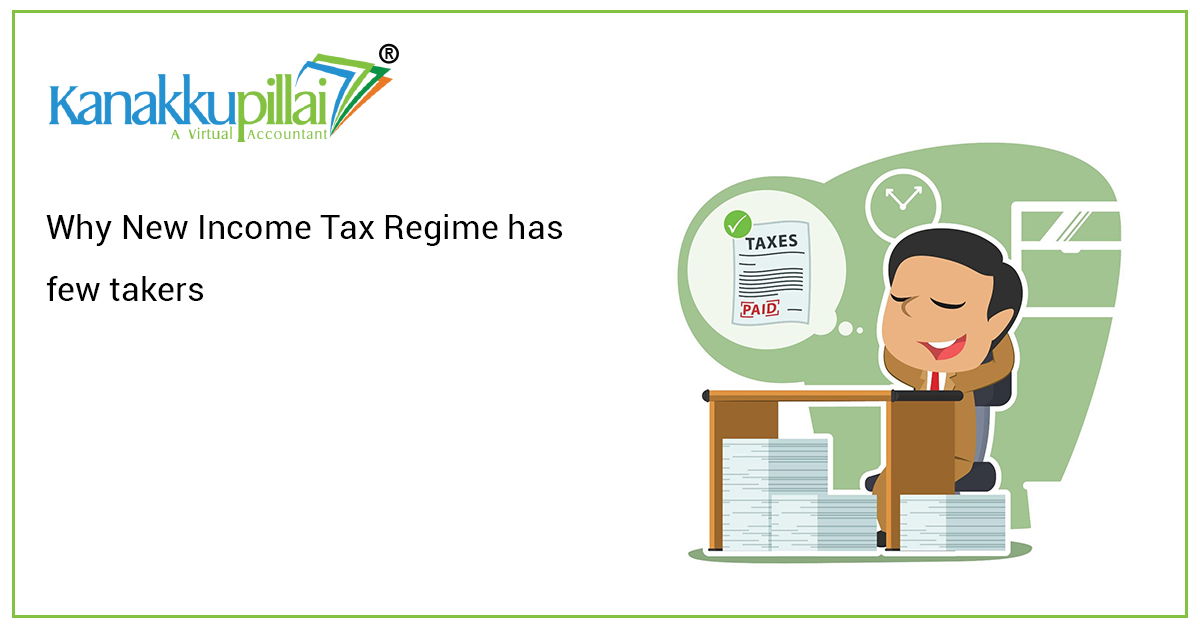The assessment year 2021-22 was the first time taxpayers who chose the new alternative tax regime established in the Budget of the year 2020 had to submit returns or ITRs under the framework. Even at the time of submitting their income tax returns, salaried taxpayers had the option of switching between two tax regimes. That is, the current tax system provides tax advantages, and the new system provides a reduced tax rate for individuals who forego the benefit of tax deductions for certain savings and spending.
Under section 115BAC of the Income Tax Act of 1961, the new tax structure took effect from the 1st of April 2020, which means from the financial year 2020-21 onwards. It excludes almost 70 of the deductions and tax benefits which were available to the taxpayers or assets, including house rent or HRA, education allowance, leave travel allowance or LTA, section 80C and 80D benefits, and the home loan interest deduction, which is made available under Section 24 of the Income Tax Act.
This has resulted in more procedural problems at the desks of both the employer companies and auditors or chartered accountants. Mr. Prashant Singh, Business Head and VP – CPO, Team lease Servicessaid that, most of the companies and HR departments believe that keeping track of employees’ choices between the two regimes adds to the complications and also adds up to their paperwork load.
Since the extended deadline for submitting income tax returns for the assessment year 2021-22 has passed, we can understand how difficult it is to cope with all these. This article is majorly focused on discussing about the old and new tax regime.
The Conversion Ratio During the Year 2021
A cross-section of tax experts reported that the new framework was only adopted by a tiny percentage of their client base. The Founder of the Chartered Club, Karan Batra, stated that, out of hundreds of their clients, only two tax payers who are high net worth individuals or the HNIs have chosen the new tax system.
The lacklustre reception may be found not just in the nation’s capital but also in other places and cities of the country. Only about 18-20 instances out of the 700 and plus clients have chosen the new tax system, was what was said by Raju Shah, who is the partner at the RCSPH & Associates in the town of Ahmedabad, in Gujarat. These taxpayers choose the new framework because they don’t want to invest and want a low effective tax rate. They make their judgement solely on the basis of the net tax liability falling on them on the basis of the income earned by them during the year.
The new system has largely gone unnoticed by tax specialists who serve the upper-income group. Those who claim deductions of at least INR 2.5 Lakh a year have stuck to the previous tax regime, was what was stated by Mr. Vaibhav Sankla, who is the Principal of Billion Basecamp Family Office. This is said to be true in case of the HNI clientele.
Who Opts for the New Tax Regime, Then?
It should be understood that a layman or an average person has no understanding of what is useful or the ability to compare the old and new tax regime to come to a healthy and useful conclusion. He’s also not organizing his year around this regime and the useful benefits it might bring in.
Instead of preparing ahead of time, people compare the two possibilities at the conclusion of the relevant financial year and choose the regime with the lowest tax liability possible. Mr. Paras Savla, a partner at KPB & Associates, told MoneyControl that the younger demographic, which does not save on tax-saving investments, is choosing the new tax system.
Younger professionals today prefer to invest in FDs or fixed deposits rather than lock in their capital in tax-saving instruments for 3-5 years, which seems to be more promising and safer. The new system was chosen by taxpayers to avoid investing money into section 80C investments, which have a lock-in term, making it difficult for them to withdraw their money during difficult times and uses that may arise unannounced. For this reason, these young customers have decided to migrate to the new system after weighing their total tax burden under both regimes.
Who Should Choose the New Tax System or Regime?
While the lower tax bracket of 5% is not accessible under the current tax system, the benefit is not duplicated in the higher brackets. The new rule is more suitable for lower-income groups, pensioners, and also freshers who may seek to minimise paperwork.
So, at what salary level does the New Tax Regime make sense?
The answer would be that; the Freshers or those who are earning less than INR 7.5 Lakh may benefit from the new system most likely.
And in case of those earning more than INR 10 Lakh have overwhelmingly decided to continue to the previous regime which is the Old Tax Regime.
The pandemic caused by the Covid-19 virus has also compelled some people to seek refuge in the low-tax, but no-deduction programme, which is the New Tax Regime. Those who have not invested, particularly during the Covid-19 era, or who have recently begun earning and need cash rather than investing them in assets, usually choose the new tax system as a place to confide in themselves.
Those with a small house loan examine the reduced tax scheme as well.
While it is normal to choose the regime that is most acceptable at the time, it is also vital to consider the future, especially if you are not a paid or earning person. Self-employed persons who may wish to take out a large house loan in the future should avoid the new tax system since home loan tax deductions provide enormous tax savings potential, especially when a couple takes out a home loan on a joint basis.
Non-Salaried Employees Face a One-Time Changeover Obstacle
While salaried workers can choose between the new and old regimes of tax, at any point during the year, self-employed workers can only do so once in their lives. Due to which it makes this decision an utmost important and crucial one.
If the option to change each year is made available to self-employed people as well, the new tax system or regime may acquire traction because these people can’t forecast their future income and can genuinely use the facility for their own benefits in different manners.
NTR’s or the New Tax Regimes appeal is hampered by a lack of knowledge and previous planning. Another issue for corporate administration teams is the paperwork burden that is coming with this.
One of the major reasons why the new system has gotten so little momentum is that businesses haven’t gone all out to raise awareness. Organizations give workers just one chance to adopt a tax regime, whether old or new, for the purpose of computing tax deducted at source or the TDS liability at the start of the financial or fiscal year. So, if employees receive bonuses or mid-year raises and discover that their chosen regime is not helpful, they must wait until return filing to change their minds, as it was already made for them during the start of the year.
Many more people might profit from the new regime’s painless system if firms and the Central Board of Direct Taxes or the CBDT work together to resolve these concerns. Under the new approach, filing tax returns would also be a lot easier.
A Guide to Help You Make a Choice on “Which tax regime?”
It is stated that you should be careful what you wish for because it could just come true and this is true as it is precisely what has occurred in the case of Indian taxpayers. They’ve been clamouring for a simpler tax system with more generous slabs and lower rates for a long time.
Finance Minister Nirmala Sitharaman has agreed to the proposal in the Union Budget 2020, but with a catch: in order to benefit from thesimplified’ NTR or new tax regime, you’ll have to give up a slew of current exemptions and deductions.
Both the present and future income-tax regimes will exist concurrently, with the opportunity to choose between the two. You, the taxpayer, must now choose which option is best for you. Ironically, the ‘ simpler’ tax system has hidden complexities that cause confusion rather than ease. Here’s a five-point checklist to help you make the best decision on which tax regime to choose, the old or the new:
For the most part, old is gold.
Financial gurus agree that the previous regime is preferable for most people who have been taking advantage of many tax incentives, particularly those that encourage you to invest, such as section 80C and 80CCD tax benefits.
In the vast majority of circumstances, the old rule will prove to be advantageous. Only individuals who did not make an attempt to invest in section 80C avenues and take advantage of other deductions, or who were unable to use the INR 1.5 Lakh limit due to greater costs, may see their tax bill decrease under the new system or the New Tax Regime.
Prepare ahead of time to make an educated decision.
The question of whether to switch or stick has no definitive solution. And it isn’t just determined by your earnings or wage structure. You should also consider your investment habits, as well as your age, life stage, aspirations, obligations, and anticipated costs. To decide whether or not to switch, you’ll need to plot your real income and deduction statistics.
For example, if you are a young person who dislikes paperwork and claims little or no tax-saving advantages, the new system may appeal to you. It will not be difficult for you to forego these tax benefits in order to have more money in your pocket.
Long-term savings should not be overlooked.
The possibility of transferring to the new system may appear appealing to millennials or those in their first or second employment who are claiming limited tax advantages due to the smaller PF deduction. After all, it will be simple to forego lesser qualified deductions while simultaneously avoiding the urge to spend more in order to claim bigger tax benefits. Aside from getting rid of paperwork, the new regime helpful for some, as they may end up with more money in their hands.
That isn’t to say that young people shouldn’t save. The desire to spend this more discretionary cash indiscriminately, especially with credit cards, might lead to reckless spending. It might not only lead to debt, but a lack of savings can also jeopardise their financial future.
According to one of the famous financial advisers, the absence of any incentive to save will be a major drawback of the proposed new tax regime. Unless you compel people to save, they will not save by nature and it is the basic habit of any person as we tend to be ignorant about our future and what might happen then.
Tax breaks are one approach to encourage people to put money down for their future. Consumption growth should not come at the expense of savings. So, advice for anyone to migrate to the new tax structure or the new tax regime should not be to escape savings and increase consumption.
On the other side, skipping section 80C eliminates the chance of any taxpayer succumbing to insurance brokers’ low-yielding endowment policy sales pitches. For long-term goal planning, disciplined investors may always go to stocks.
NPS, or National Pension Scheme, now has the Upper Hand
The new tax system does provide one tax benefit and that is the national pension scheme or the NPS. Nirmala Sitharaman, the finance minister, stated in her Budget statement that roughly 70 exemptions and deductions will be eliminated from the new tax system out of a total of over 100.
Some tax perks have been spared the axe. One such tax advantage is your employer’s payment to the NPS, which is deductible from your salary under section 80CCD (2) of Income Tax Act. The maximum amount you can deduct is 10% of your base pay + dearness allowance. Regardless of whether you like the old or new system, make sure you ask whether your company provides this choice and accept it.
Choose your charity carefully.
Donations to non-profit organisations are now one of the deductions you may claim. Section 80G allows you to claim 50 or 100 percent of the amount given, depending on the organisation. The difficulty for taxpayers has been claiming the deduction, as contributors were required to keep the receipt after the fiscal financial year ended. This was due to the fact that he/she had to fill out the tax return form with information such as the receipt number, name and address of the charity institution, PAN, and the amount contributed duly.
Budget 2020 has made things a little easier and simple.
Now, the income-tax department will obtain your gift information directly from charity organisations and include it in your income-tax form. In other words, your contribution actions will be pre-filled on your tax return. One of the most important requirements is that the non-profit organisation be registered with the IT department and have a unique registration number. If you provide money, make sure your charity trust has gone through this process.
But making your call regarding whether to follow old or new tax regime is not an easy one when looked from a layman point of view. So, seeking experts advise would always help you get on the right track and get the maximum benefit without compromising your chance to save the maximum and also enjoy lower tax brackets.
We have our team real equipped and ready to advise you and get the best available benefit for you. You simply need to click here Kanakkupillai and get access to our expert body who are experienced to assist you.





